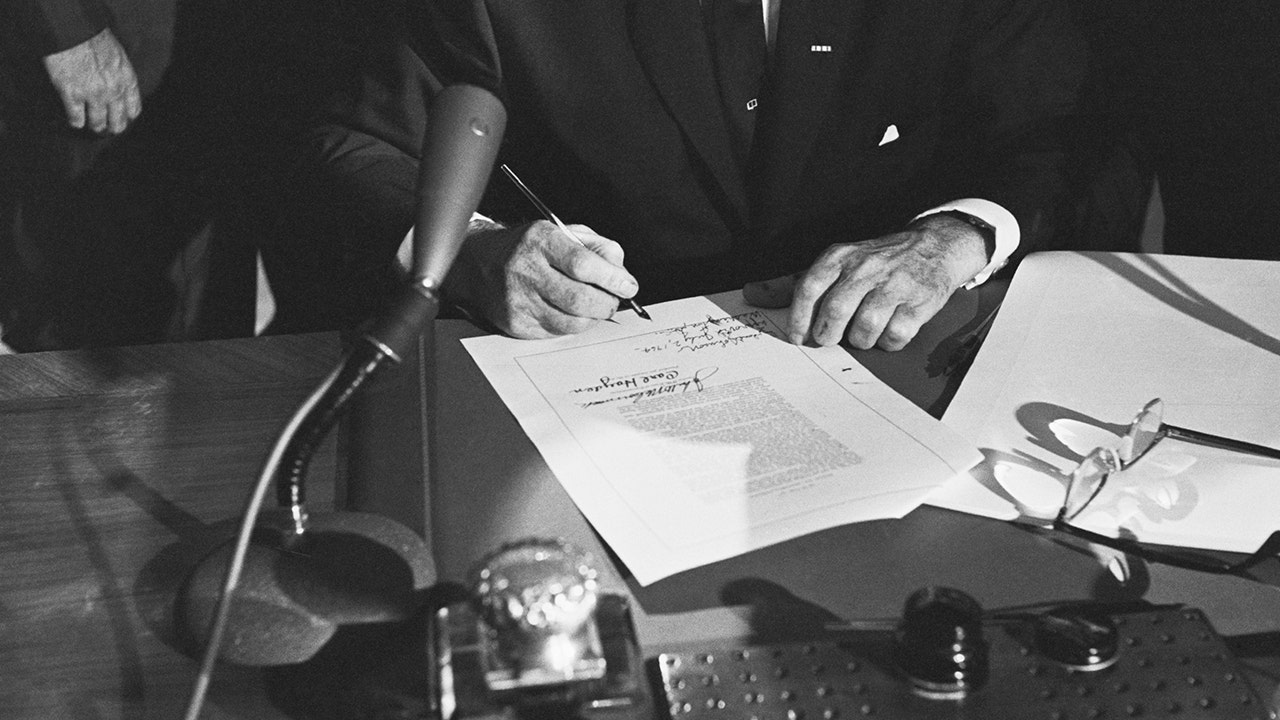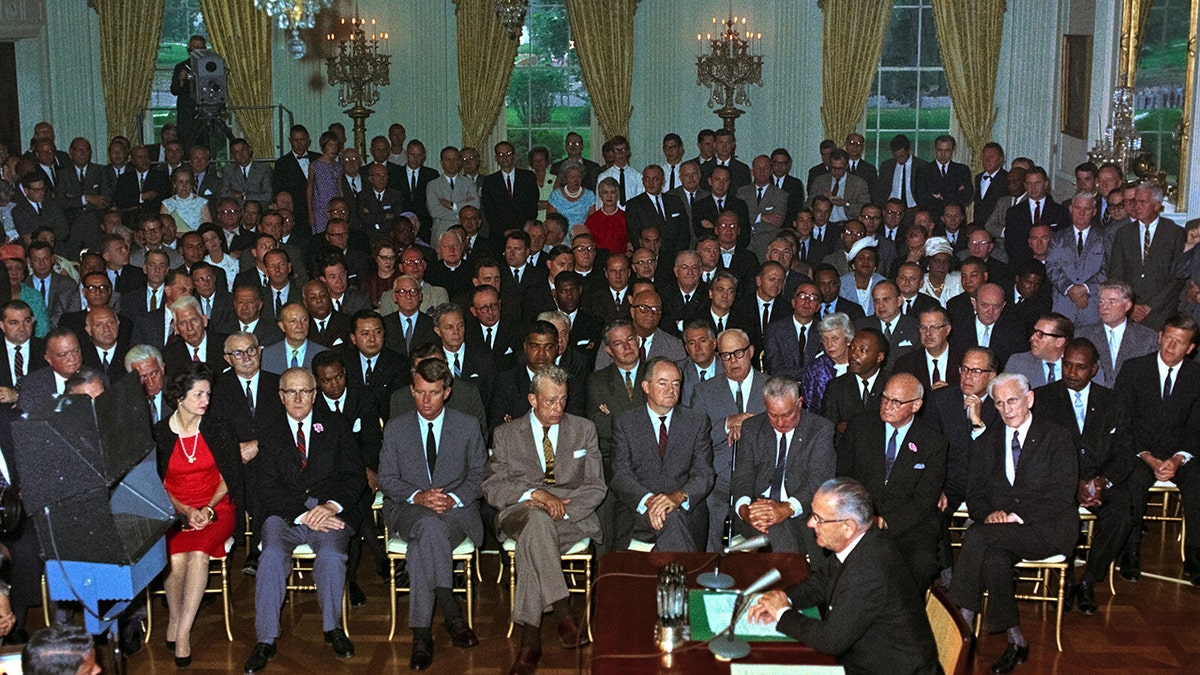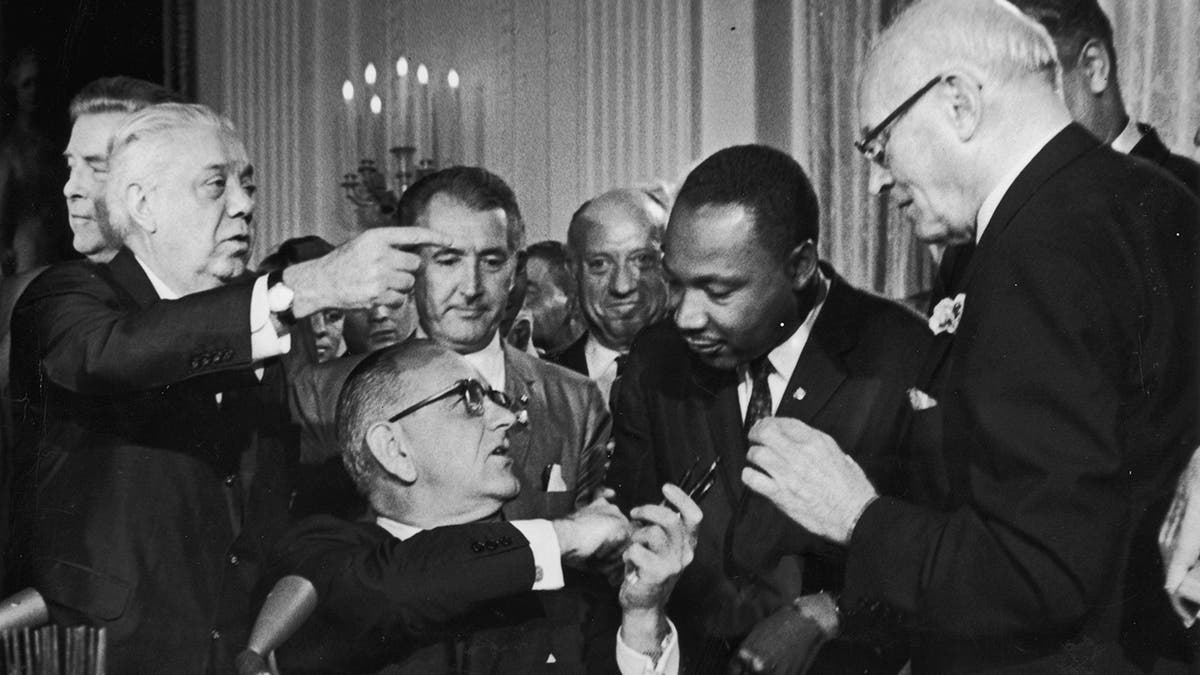
President Lyndon B. Johnson signed the Civil Rights Act of 1964 into law on this day in history, July 2, 1964 — “the most sweeping civil rights legislation since Reconstruction,” as the National Archives notes on its website.
The Civil Rights Act of 1964 “prohibited discrimination in public spaces, provided for the integration of schools and other public facilities, and made employment discrimination illegal,” according to the Archives.
The passage of the Civil Rights Act was a long time in coming, said the same source.
ON THIS DAY IN HISTORY, JULY 1, 1847, THE US POST OFFICE ISSUES THE FIRST STAMPS
On June 6, 1963, then-President John F. Kennedy addressed racial equality in a nationally televised speech.
Later, Kennedy requested that Congress move forward with legislation “that would address voting rights, public accommodations, school desegregation, nondiscrimination in federally assisted programs and more.”

President Lyndon B. Johnson signed the Civil Rights Act into law on this day in history, July 2, 1964. The act was a long time in coming — and had been proposed by Johnson’s predecessor, John F. Kennedy. (Getty Images)
That request from Kennedy eventually would become the Civil Rights Act of 1964, although he would not get to see it.
He was assassinated in Dallas, Texas, on Nov. 22, 1963.
After Johnson was sworn in as president, he began working on making Kennedy’s dream a reality.
ON THIS DAY IN HISTORY, NOV. 22, 1963, JOHN F. KENNEDY, 35TH PRESIDENT, IS ASSASSINATED
The law faced many obstacles in both houses of Congress, said the National Archives.
In the House of Representatives, opponents of the bill attempted to stymie its process in the Rules Committee.
ON THIS DAY IN HISTORY, DEC. 1, 1955, ROSA PARKS REFUSES TO GIVE UP HER BUS SEAT TO A WHITE PASSENGER
The House of Representatives passed H.R. 7152 on Feb. 10, 1964, sending the bill to the Senate, said the website of the United States Senate.

President Lyndon B. Johnson (center, seated) shakes the hand of Dr. Martin Luther King Jr. at the signing of the Civil Rights Act in 1964. (Hulton Archive/Getty Images)
In an effort to avoid the same committee delays on the Senate side, Senate Majority Leader Mike Mansfield, D-Montana, bypassed the Senate Judiciary Committee and put the bill on the Senate calendar, according to the Senate’s website.
At the time, the chair of the Judiciary Committee was Sen. James Eastland, D-Mississippi, an opponent of civil rights legislation.
ON THIS DAY IN HISTORY, JAN. 4, 1965, LBJ TOUTS UTOPIAN ‘GREAT SOCIETY’ IN STATE OF THE UNION ADDRESS
“Mansfield moved to take up the measure on March 9 and it became the Senate’s pending business on March 26, prompting southern senators to launch a filibuster,” the Senate website notes.
The filibuster and other debate on the bill lasted until June 10, 1964, when cloture was invoked. This came after an impressive amount of bipartisanship.
In late May, Senate Minority Leader Everett Dirksen, R-Illinois, introduced the Dirksen-Mansfield-Kuchel-Humphrey “compromise bill” that both Republican and Democrat members backed.

The Civil Rights Act of 1964 was signed on July 2, 1964. The other signatures on the bill are those of House Speaker John McCormack and of President Pro Tempore of the Senate Carl Hayden. (Getty Images)
“Previously an opponent of civil rights legislation, Sen. Dirksen urged Republicans to support the bill as ‘an idea whose time has come,'” said the Library of Congress website.
The actions of Republican and Democratic leadership in the Senate was enough to end the months-long filibuster.
Johnson signed the bill surrounded by notable civil rights leaders.
“The Senate filibuster was overcome through the floor leadership of Sen. Hubert Humphrey of Minnesota, the considerable support of President Lyndon Johnson, and the efforts of Sen. Minority Leader Everett Dirksen of Illinois, who convinced enough Republicans to support the bill over Democratic opposition,” said the National Archives.
CLICK HERE TO SIGN UP FOR OUR LIFESTYLE NEWSLETTER
The Senate finally voted on the bill on June 19, 1964 — and it passed by a vote of 73 to 27.
The new compromise bill was sent to the House of Representatives, where it, too, was passed.
CLICK HERE TO GET THE FOX NEWS APP
Johnson signed the bill surrounded by notable civil rights leaders, including Martin Luther King Jr.
Christine Rousselle is a lifestyle reporter with Fox News Digital.
This post originally appeared on and written by:
Randy Schewe
Fox News 2023-07-02 04:02:00
